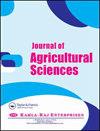Relationship Between Resistance Against Neonicotinoids and Esterase Enzyme for Myzus persicae (Sulzer) (Hemiptera:Aphididae) Populations in South of Turkey
IF 0.7
Q3 AGRICULTURE, MULTIDISCIPLINARY
引用次数: 0
Abstract
In this study, the development of imidacloprid and acetamiprid resistance in Myzus persicae populations and the relationship between neonicotinoid resistance and esterase enzyme were investigated in seven Myzus persicae populations which is collected from greenhouse pepper production areas in 2018. In order to determine the resistance ratios of aphid populations against the insecticides, 1 control and 6 doses were used. Each insecticide dose was used in 3 replicates and 25 adult female individuals were used in each replication. For imidacloprid, the highest and the lowest resistance ratios were found to be 6.88 and 3.19-fold, in K-4 and D populations, respectively. For acetamiprid, the highest and the lowest resistance ratios were found to be 7.35 and 2.72-fold, in K-1 and E-2 populations, respectively. Also, highest and lowest esterase activities were found to be 2.60 and 1.75 mOD min-1 mg-1 in K-4 and E-2 populations, respectively. According to the results of this study, imidacloprid and acetamiprid resistance determined in some Myzus persicae populations may be related to esterase enzyme. However, detailed studies are required to establish a clear relationship between resistance and enzyme.土耳其南部桃蚜(半翅目:蚜虫科)种群对新烟碱类杀虫剂抗性与酯酶的关系
本研究以2018年在温室辣椒产区收集的7个桃蚜种群为研究对象,研究了桃蚜种群对吡虫啉和啶虫啉的抗性发展以及新烟碱类抗性与酯酶的关系。采用1个对照和6个剂量测定蚜虫种群对杀虫剂的抗性。每个剂量用3个重复,每个重复用25只雌性成虫。对吡虫啉,K-4和D种群的最高抗性倍数为6.88倍,最低抗性倍数为3.19倍。K-1和E-2种群对啶虫脒的抗性倍数最高为7.35倍,最低为2.72倍。K-4和E-2群体酯酶活性最高和最低分别为2.60和1.75 mOD min-1 mg-1。本研究结果表明,部分桃蚜种群对吡虫啉和啶虫啉的抗性可能与酯酶有关。然而,需要详细的研究来建立抗性和酶之间的明确关系。
本文章由计算机程序翻译,如有差异,请以英文原文为准。
求助全文
约1分钟内获得全文
求助全文
来源期刊

Journal of Agricultural Sciences
AGRICULTURE, MULTIDISCIPLINARY-
CiteScore
1.80
自引率
0.00%
发文量
0
 求助内容:
求助内容: 应助结果提醒方式:
应助结果提醒方式:


